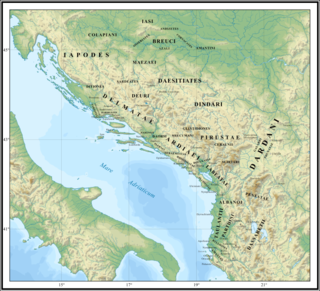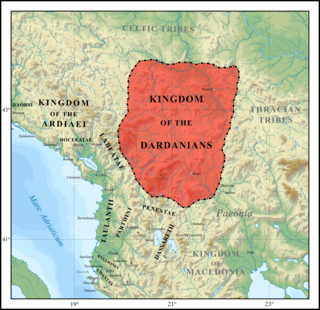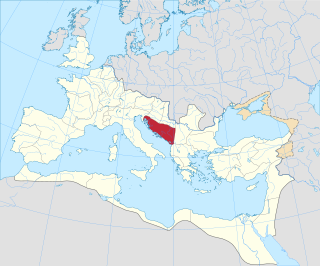Related Research Articles

In classical and late antiquity, Illyria was a region in the western part of the Balkan Peninsula inhabited by numerous tribes of people collectively known as the Illyrians.
The Triballi were an ancient people who lived in northern Bulgaria in the region of Roman Oescus up to southeastern Serbia, possibly near the territory of the Morava Valley in the late Iron Age. The Triballi lived between Thracians to the east, Illyrians the west and Celts to the north and were influenced by them. As such in contemporary sources, they are variably described as an independent, Thracian, Illyrian or Celtic tribe. Strabo considered the Triballi as a Thracian people. Most ancient sources considered the Triballi as Thracians, while some regarded them as Illyrians.

The Scordisci were an Iron Age cultural group who emerged after the Celtic settlement of Southeast Europe, and who were centered in the territory of present-day Serbia, at the confluence of the Savus (Sava), Dravus (Drava), Margus (Morava) and Danube rivers. They were historically notable from the beginning of the third century BC until the turn of the common era, and consolidated into a tribal state. At their zenith, their core territory stretched over regions comprising parts of present-day Serbia, Croatia, Bulgaria and Romania, while their influence spread even further. After the Roman conquest in the 1st century AD, their territories were included into the Roman provinces of Pannonia, Moesia and Dacia.

The Illyrians were a group of Indo-European-speaking people who inhabited the western Balkan Peninsula in ancient times. They constituted one of the three main Paleo-Balkan populations, along with the Thracians and Greeks.

The Dardani or Dardanians were a Paleo-Balkan people, who lived in a region that was named Dardania after their settlement there. They were among the oldest Balkan peoples, and their society was very complex. The Dardani were the most stable and conservative ethnic element among the peoples of the central Balkans, retaining an enduring presence in the region for several centuries.
Taulantii or Taulantians were an Illyrian people that lived on the Adriatic coast of southern Illyria. They dominated at various times much of the plain between the rivers Drin (Drilon) and Vjosa (Aoös). Their central area was the hinterland of Epidamnos-Dyrrhachion, corresponding to present-day Tirana and the region between the valleys of Mat and Shkumbin (Genusus). The Taulantii are among the oldest attested Illyrian peoples, who established a powerful kingdom in southern Illyria. They are among the peoples who most marked Illyrian history, and thus found their place in the numerous works of historians in classical antiquity.

The Autariatae or Autariatai were an Illyrian people that lived between the valleys of the Lim and the Tara, beyond the Accursed Mountains, and the valley of West Morava. Their territory was located inland from the Ardiaei and the Lake Skodra, extending east to the Dardani and north or northeast to the Triballi.

Illyrius is the son of Cadmus and Harmonia, who eventually ruled Illyria and became the eponymous ancestor of the Illyrians. Illyrius/Illyriós/Illyri is a name known in different stories found in ancient Greek mythology.
The Ardiaei were an Illyrian people who resided in the territory of present-day Albania, Kosovo, Montenegro, Bosnia and Herzegovina, and Croatia between the Adriatic coast on the south, Konjic on the north, along the Neretva river and its right bank on the west, and extending to Lake Shkodra to the southeast. From the 3rd century BC to 168 BC the capital cities of the Ardiaean State were Rhizon and Scodra.

The Kingdom of Dardania was a polity in the central Balkans in the region of Dardania during classical antiquity. It is named after the Dardani, a Paleo-Balkan tribe that formed the core of the Dardanian polity. Dardania was centered around present-day Kosovo, but also included parts of North Macedonia, Serbia and Albania. The eastern parts of Dardania were at the Thraco-Illyrian contact zone. Marcus Licinius Crassus, grandson of the triumvir Marcus Crassus, officially annexed the kingdom in 28 BC while on campaign against the Dacians and Bastarnae. The region was subsequently incorporated into the province of Moesia in 15 BC, and later in 293 AD, as the province of Dardania.

Dalmatia was a Roman province. Its name is derived from the name of an Illyrian tribe called the Dalmatae, which lived in the central area of the eastern coast of the Adriatic Sea. It encompassed the northern part of present-day Albania, much of Croatia, Bosnia and Herzegovina, Montenegro,and Serbia, thus covering an area significantly larger than the current Croatian and Montenegrin region of Dalmatia. Originally this region was called Illyria or Illyricum.

Dardania was a Roman province in the Central Balkans, initially an unofficial region in Moesia (87–284), and then a province administratively part of the Diocese of Moesia (293–337). It was named after the tribe of the Dardani who inhabited the region in classical antiquity prior to the Roman conquest. During the late Imperial period the Dardanian territory was the homeland of many Roman emperors, notably Constantine the Great and Justinian I.
The Parthini, Partini or Partheni were an Illyrian tribe that lived in the inlands of southern Illyria. They likely were located in the Shkumbin valley controlling the important route between the Adriatic Sea and Macedonia, which corresponded to the Via Egnatia of Roman times. Consequently, their neighbours to the west were the Taulantii and to the east the Dassaretii in the region of Lychnidus.
Illyrian religion refers to the religious beliefs and practices of the Illyrian peoples, a group of tribes who spoke the Illyrian languages and inhabited part of the western Balkan Peninsula from at least the 8th century BC until the 7th century AD. The available written sources are very tenuous. They consist largely of personal and place names, and a few glosses from Classical sources.

The Illyrian Kingdom was an Illyrian political entity that existed on the western part of the Balkan Peninsula in ancient times. Regardless of the number of the alternately ruling dynasties, of their tribal affiliation, and of the actual extension of their kingdom, it represented an alliance of Illyrian tribes that united under the rulership of a single leader, expressly referred to as "King of the Illyrians" in ancient historical records. The monarchic superstructure of the Illyrian state coexisted with the Illyrian tribal communities and the republican system of the Illyrian koina.
The Dassaretii were an Illyrian people that lived in the inlands of southern Illyria, between present-day south-eastern Albania and south-western North Macedonia. Their territory included the entire region between the rivers Asamus and Eordaicus, the plateau of Korça locked by the fortress of Pelion and, towards the north it extended to Lake Lychnidus up to the Black Drin. They were directly in contact with the regions of Orestis and Lynkestis of Upper Macedonia. Their chief city was Lychnidos, located on the edge of the lake of the same name. One of the most important settlements in their territory was established at Selcë e Poshtme near the western shore of Lake Lychnidus, where the Illyrian Royal Tombs were built.
The Enchelei were an ancient people that lived around the River Drin and the region of Lake Shkodra and Lake Ohrid, in modern-day Albania, Montenegro, and North Macedonia. They are one of the oldest known peoples of the eastern shore of the Adriatic Sea. In ancient sources they sometimes appear as an ethnic group distinct from the Illyrians, but they are mostly mentioned as one of the Illyrian tribes. They held a central position in the earlier phase of Illyrian history. In ancient Greek literature they are linked with the end of the mythical narrative of Cadmus and Harmonia, a tradition deeply rooted among the Illyrian peoples.

Fanula Papazoglu was a Yugoslav classical scholar, epigrapher and academic. She was an expert in Ancient history of the Balkans. She founded the Centre for Ancient Epigraphy and Numismatics in 1970.
The Penestae were an Illyrian tribe dwelling in southeastern Illyria, in an inland region that was called Penestia, which was located around the Black Drin valley north of Lake Ohrid, between present-day eastern Albania and western North Macedonia. They are firstly mentioned by ancient Roman historian Livy. They appear several times in Livy's accounts of the events concerning the Third Macedonian War, which was fought between the Roman Republic and the Kingdom of Macedonia under Perseus. Their chief city was Uscana, most likely located in the valley of the Black Drin in the region of Dibra.
Illyrology or Illyrian studies is interdisciplinary academic field which focuses on scientific study of Illyria and Illyrians as a regional and thematic branch of the larger disciplines of ancient history and archaeology. A practitioner of the discipline is called Illyrologist. His duty is to investigate the range of ancient Illyrian history, culture, art, language, heraldry, numizmatic, mythology, economics, ethics, etc. from c. 1000 BC up to the end of Roman rule around the 5th century.
References
Citations
- 1 2 Herodotus, Hist. , Book I, Ch. 196.
- ↑ Eichner 2004, pp. 97, 99.
- ↑ Papazoglu 1978 , p. 218; Polomé 1982 , p. 866; Stipčević 1989 , p. 26; Eichner 2004 , pp. 97, 99; Šašel Kos 2005 , p. 235; Demiraj 2006 , pp. 56–57; Matijašić 2011 , p. 301.
- ↑ Papazoglu 1978 , p. 177; Matijašić 2011 , pp. 300–301; Eichner 2004 , pp. 97, 99.
- ↑ See also slavery in antiquity.
- ↑ Papazoglu 1978, p. 177.
- ↑ Matijašić 2011, pp. 300–301.
- ↑ Appian, Mithridatic Wars, Book VIII, Ch. 55.
- ↑ Papazoglu 1978 , p. 177; Matijašić 2011 , pp. 300–301.
- ↑ Eustathius, Comm. Hom. Il., Book II, Ch. 852, §1.
- ↑ Matijašić 2011 , p. 301
Bibliography
- Demiraj, Shaban (2006). The origin of the Albanians: linguistically investigated. Academy of Sciences of Albania. ISBN 9789994381715. Archived from the original on 20 November 2020.
- Eichner, Heiner (2004). "Illyrisch – die unbekannte Sprache". In Eichner, Heiner (ed.). Die Illyrer. Archäologische Funde des 1. Vorchristlichen Jahrtausends aus Albanien (in German). Museum für Urgeschichte Asparn an der Zaya. pp. 92–117. ISBN 3-85460-215-4.
- Matijašić, Ivan (2011). ""Shrieking like Illyrians": Historical geography and the Greek perspective of the Illyrian world in the 5th century BC". Arheološki Vestnik. 62. Research Centre of the Slovenian Academy of Sciences and Arts: 289–316.
- Papazoglu, Fanula (1978). The Central Balkan Tribes in pre-Roman Times: Triballi, Autariatae, Dardanians, Scordisci and Moesians. Amsterdam: Hakkert. ISBN 9789025607937.
- Polomé, Edgar (1982). "Balkan Languages (Illyrian, Thracian and Daco-Moeasian)". In J. Boardman; I. E. S. Edwards; N. G. L. Hammond; E. Sollberger (eds.). The Cambridge Ancient History: The Prehistory of the Balkans; and the Middle East and the Aegean world, tenth to eighth centuries B.C. Vol. III (part 1) (2 ed.). Cambridge University Press. ISBN 0521224969.
- Šašel Kos, Marjeta (2005). Appian and Illyricum. Narodni muzej Slovenije. ISBN 961616936X.
- Stipčević, Aleksandar (1989). Iliri: povijest, život, kultura (in Croatian). Zagreb: Školska knjiga. ISBN 9788603991062.